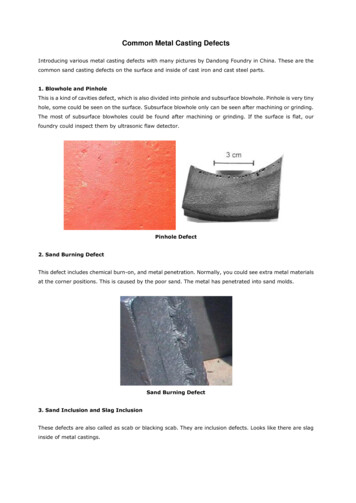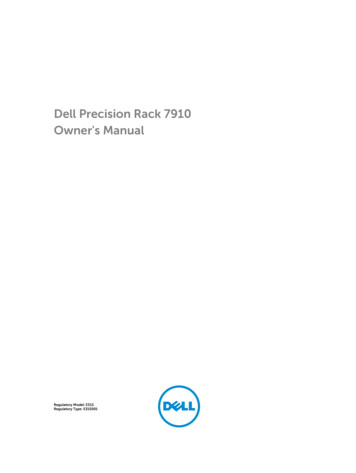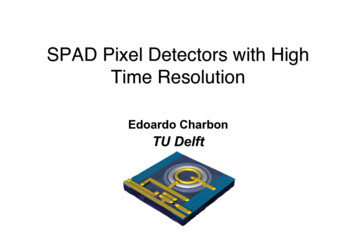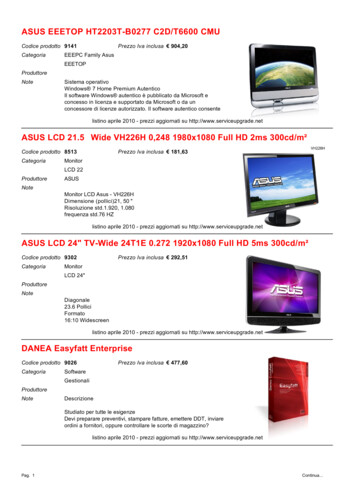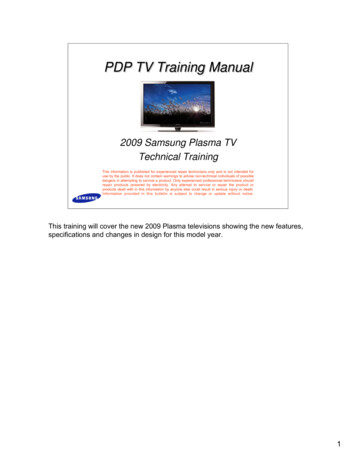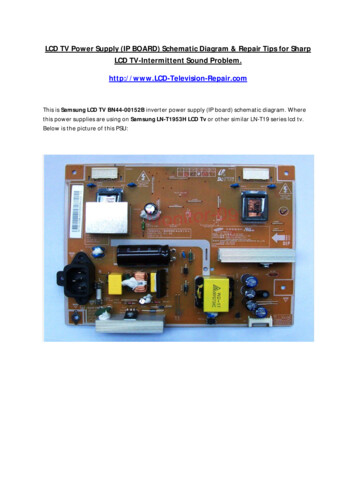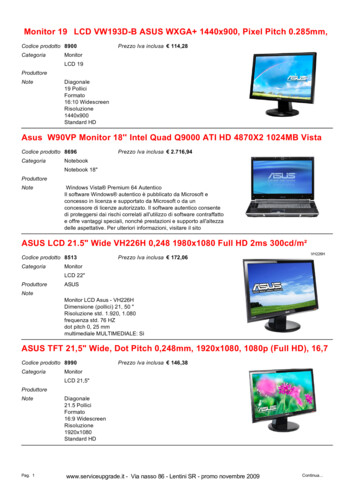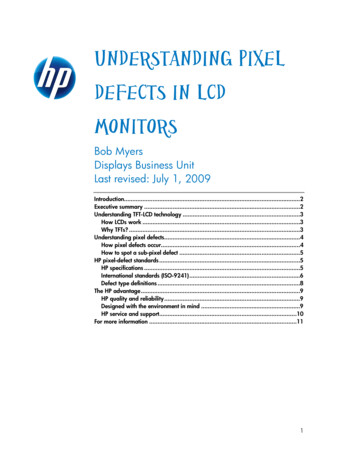
Transcription
Understanding pixeldefects in LCDmonitorsBob MyersDisplays Business UnitLast revised: July 1, 2009Introduction.2Executive summary .2Understanding TFT-LCD technology .3How LCDs work .3Why TFTs? .3Understanding pixel defects.4How pixel defects occur.4How to spot a sub-pixel defect .5HP pixel-defect standards .5HP specifications .5International standards (ISO-9241) .6Defect type definitions .8The HP advantage .9HP quality and reliability .9Designed with the environment in mind .9HP service and support.10For more information .111
IntroductionLiquid crystal display (LCD) technology was first invented decades ago and hasbeen improving ever since—to the point that today’s high-quality flat panel displaysdeliver crisp, clear visual quality at a reasonable price. Even so, some LCD monitorsmay harbor tiny defects due to the extreme complexity of the manufacturingprocess. To deal with these inevitable minor flaws, HP has developed a set ofpolicies and detection methods to help ensure that each customer receives thehighest quality product available.Executive summaryFlat panel LCD technology is a complex subject. To help you understand how pixeland sub-pixel defects occur, and what HP does about them, this white paperexplains: What are sub-pixels and how do they work? A detailed look will show thatmillions of tiny sub-pixels cover the typical flat panel screen, producing themixture of color and detail that forms the sharp, vibrant images flat panel usershave come to expect. How do pixel and sub-pixel defects occur? The HP specification does not allowfor any full or complete pixel defects. It does, however, allow for some minimalsub-pixel defects. This is because the current state-of-the-art in manufacturingprocesses still may produce a few sub-pixel defects per screen. These defectscan be extremely hard to see unless they are viewed under special conditions,or unless they happen to be clustered in groups. Nevertheless, special practicesand policies have been devised to reject any complete pixel defects andminimize sub-pixel defects. What is HP doing about it? HP has conducted a detailed study of its standardsfor sub-pixel defect specifications, and as a result, has adopted a morestringent unified standard for all models, which is discussed in greater detaillater in this paper. Why is this important to me? Doing business with HP gives you the advantageof dealing with a company that strives to consistently deliver a higher standardof quality to its customers. In this case, no full or complete pixel defects, andfewer sub-pixel defects than most competitors. This means better quality for thecustomer and ultimately greater satisfaction for the end user because the user isviewing a cleaner image without the distraction of pixel defects.2
Understanding TFT-LCD technologyThin-film transistor (TFT) technology refers to a type of liquid crystal display (LCD),also known as an active-matrix LCD (AMLCD), used in all HP LCD monitors as wellas HP iPAQ devices and HP notebook displays. To understand how pixel defectsoccur, it helps to understand the technology behind this type of LCD.How LCDs workA liquid crystal is exactly what it sounds like: a fluid substance which also exhibitssome properties—such as an ordered arrangement of its molecules—similar to asolid crystal. In 1963, an RCA researcher discovered that liquid crystals can beused to control light, by switching a voltage across the material on and off. Beforelong, the technology was being applied to everything from calculators to computermonitors.Because of their long, rod-like shape and electrical properties, liquid crystalmolecules tend to line up in parallel rows in their natural state. When used incomputer displays, this material is enclosed between two pieces of glass (in a flatpanel display) and an image is generated by controlling the alignment of the LCmolecules electrically, causing them to effectively act as “light valves”—letting lighteither pass through the panel or be blocked, depending on the voltage appliedacross the material. Color filters are placed on one side of the glass panels, withthree different colors (red, green, and blue) for each pixel. Combining red, green,and blue light in different amounts, controlled by the voltage applied across the LCmaterial at each of these individual areas (called subpixels) lets each pixel appearas any color and any brightness, and the combination of all the pixels on the panelcreates the complete image.Fluorescent lights (very similar to the fluorescent tubes used in standard officelighting, but much smaller) or light-emitting diodes (LEDs) provide the “backlighting”for the LCD display—the light that will pass through the panel from the rear, and socreate the image. The light from the backlight unit passes through a translucentplastic diffuser layer, which spreads the light evenly across the screen.Why TFTs?In the simplest LCD technology, the voltage applied across the LC material isdelivered by transparent row and column electrodes, lines of conductive materialwhich cross at 90 degrees (one set on the “top” glass, and the other on thebottom). The intersection of rows and columns define the pixels and subpixels of thedisplay, and applying a voltage to a given row and column switches the pixel atthat particular intersection. If the panel is driven such that the pixels are switched, inorder across the display, very rapidly, the appearance of a complete image isproduced. Unfortunately, when the drive voltage is removed from a given pixel andwe move on to the next, that first pixel starts to switch back to its “off” state. Thislimits the contrast, resolution, and the response time that can be achieved with sucha simple, passive-matrix drive system.3
The advent of thin-film transistor (TFT) technology allowed transistors to be placed ateach picture element or sub-pixel. These can switch very quickly, and then hold thestate of the sub-pixel while the panel drivers take care of the other rows andcolumns of the display. This results in a great improvement in the contrast andresponse time possible with LCD technology, and permits the manufacture of largesize, high-resolution displays which rival any other display technology inperformance.Figure 1. How thin-film transistors are placed in the LCD array.Electrodes acrossLC materialUnderstanding pixel defectsActive-matrix TFT-LCDs require at least one transistor to be created at each subpixelon the panel. This makes the average AMLCD an enormously complex device. Forexample, producing one of today’s high-resolution WUXGA displays. with a 1920x 1200 pixel native format requires embedding nearly seven million transistors inthe screen (1920 x 1200 x 3 6.91 million). This is more than double the numberof transistors found in the original Intel Pentium processor.How pixel defects occurDamage to any one of the millions of transistors within the LCD panel may leave asub-pixel permanently on or off, creating a tiny dark spot or bright spot on thedisplay. This is fairly common, even for small TFT displays on handheld computers.Minute specks of dust on the panel, slight errors in the panel processing, and otherproblems encountered during manufacturing of the TFT array on the glass substratecause these defects. When we look at the total number of pixels and subpixels on a1920 x 1200 display, we see that the failure of one sub-pixel out of the 6.91million is a very low failure rate indeed—only about 14 millionths of one percent(0.000014%). For lower-resolution SXGA displays, a single sub-pixel defect stillrepresents a failure rate of only 25 millionths of one percent.To look at it another way, having 10 sub-pixel defects on a 1280 x 1024 colorpanel means that the panel is still 99.9999% defect free!4
How to spot a sub-pixel defectDue to their tiny size relative to the screen, defective sub-pixels can be extremelyhard to see. A defect in a sub-pixel is, visually, a single, tiny spot that is so small, itmay be visible only if you display it against a background that specifically contrastswith the defective sub-pixel hue.Because they appear brighter to the human eye, defective green sub-pixels may beeasier to spot than defective red or blue ones. Sub-pixel defects are also easier tospot when they are clustered together in a single area. If all three sub-pixels in thesame pixel fail simultaneously, you are more likely to detect the resulting light ordark pixel. However, since HP specifications require that TFT panels not have anycomplete pixel defects (i.e., all three sub-pixels defective), HP customers are notlikely to encounter this situation.To locate defective sub-pixels, the monitor should be viewed under normaloperating conditions, in normal operating mode at a supported resolution andrefresh rate, from a distance of approximately 20 inches (51 cm). The followingstandards show the typical conditions under which HP scans for pixel defects: Viewing distance of approximately 14 inches (36 cm) Ambient illumination of 300 to 500 lux (average room lighting can vary from60 to 600 lux; typical museum lighting is 50 lux). Viewing angle of 70 to 110 degrees horizontal and 80 to 100 degrees verticalHP pixel-defect standardsSince some degree of sub-pixel defects are inevitable, all manufacturers find itnecessary to tolerate a minimal number of sub-pixel defects in their products.Replacing a panel with just a few minor sub-pixel defects is not recommended,since the replacement unit may also have a similar number of defects.Historically, HP has maintained stringent manufacturing specifications for pixeldefects, and it has been tightening those specifications over time.HP specificationsHP pixel defect specifications continue to be refined, but will always represent thebest panel quality standards which can reasonably be achieved, consistent withexpected panel yields, the need to deliver products at competitive costs, and mostimportantly the goal of producing high-quality images on our displays. In asimplified format, the pixel defect specifications are as follows:Table 1. This policy applies for HP monitors manufactured before May 2009:Bright sub-pixel defects:3 maximumDark sub-pixel defects:5 maximumTotal sub-pixel defects:5 maximumFull pixel defects:0 allowed5
Table 2. This policy applies for HP monitors manufactured in May 2009 or later:Bright sub-pixel defects:2 maximumDark sub-pixel defects:5 maximumTotal sub-pixel defects:5 maximumFull pixel defects:0 allowedNote: the date of manufacture is on the label on the back of the HP monitor.As a result of these tight specifications, the majority of all HP monitors are shippingwith no pixel defects at all (per HP’s internal audits), and a small percentage withonly a single sub-pixel defect. Most remaining units are shipping with only a fewpixel defects that fall within the above listed range of acceptable pixel defects.International standards (ISO-9241)The International Standards Organization (ISO) has published its own set ofspecifications for pixel defects, contained within the ISO 9241 set of standards.These identify three classes for measuring pixel defects in flat panel monitors: Class 0 panels are completely defect-free, including no full pixel or sub-pixeldefects. Class 1 panels permit any or all of the following: 1 full bright (“stuck on”) pixel 1 full dark (“stuck off”) pixel 2 single or double bright or dark sub-pixels 3 to 5 “stuck on” or “stuck off” sub-pixels (depending on the number ofeach) Class 2 panels permit any or all of the following: 2 full bright pixels 2 full dark pixels 5-10 single or double bright or dark sub-pixels (again, depending on thenumber of each; no more than 5 bright (“stuck on”) subpixels arepermitted). Class 3 panels permit any or all of the following: 5 full bright pixels 15 full dark pixels 50 single or double sub-pixels stuck on or offThe HP specification ensures that all of our products exceed the ISO Class 2requirements, as no full pixel defects are ever permitted; in most cases, HP displayswill meet the more stringent Class 1 specification. As mentioned earlier, the HPspecifications dictate no full pixel defects; further, we require no double sub-pixel6
defects, and no sub-pixel defects spaced closer than 15 mm, with a maximum offive total sub-pixel defects.Figure 2. Pixel fault definitions.7
Defect type definitionsBright/dark dot: A sub-pixel stuck on or off.Bright spots/lines: Spots or lines that appear light in the display. Defects do notvary in size or intensity (contrast) when contrast voltage is varied. Contrast variationcan be achieved through the use of varying gray shade patterns. This defect maynot completely block the light emitted by any pixels.Cluster: A group of defective sub-pixels which are in close proximity to each other.Cross lines off: When the unit lights, lines in both the minor and major axis do notappear.Dark spots/lines: Spots or lines that appear dark in the display patterns and areusually the result of contamination. Defects do not vary in size or intensity (contrast)when contrast voltage is varied. Contrast variation can be achieved through the useof varying gray shade patterns. This defect may not completely block the lightemitted by any pixels.Dim line: When the unit lights, line(s) in the minor (vertical) or major (horizontal)axis appear dim, but not completely on or off.Horizontal line: A line of pixels that crosses the display horizontally in portraitmode.Mottling: When the unit lights, variation/non-uniformity (splotchiness) appears light(white) with the display and might vary in size.Newton ring: A “rainbow” effect caused by non-uniform cell thickness.Pixel: A picture element made up of three primary color sub-pixels (red, green, andblue), which combine to represent a single color dot on the display.Polarizer dent: Physical damage to the polarizer that does not damage the glass.When the unit lights, spots appear light (white) with display patterns dark and donot vary in size. This defect may not completely block the light emitted by anypixels.Polarizer scratch: Physical damage to the polarizer that does not damage the glass.When the unit lights, lines appear light (white) with display patterns dark and donot vary in size. This defect may not completely block the light emitted by anypixels.Rubbing line/defects: Horizontal or diagonal lines that appear gray with thedisplay patterns dark and may have resulted from an “out of control” rubbingprocess on the polyimide or “waves” on the BEFs or prism sheets.Sub-pixel: A single point of light representing a primary color (red, green, or blue),which combines with the other two primary color sub-pixels to form a completepixel.Vertical line: A line of pixels that crosses the display vertically in portrait mode.8
The HP advantageThe HP pixel defect specifications are part of HP’s ongoing effort to provide highquality products. When it comes to LCD-TFT displays, fewer pixel defects meanbetter quality.HP quality and reliabilityHP prides itself on a reputation for industry-standard best-of-breed products—andour line of LCD monitors is a testament to that reputation. HP quality and reliabilityhelps reduce maintenance, repair, and support costs throughout the monitorlifecycle and result in a high residual value for HP products. The HP strong marketshare reflects a global awareness and strong customer loyalty to the HP full line ofinnovative and competitively priced products. Here’s how HP builds quality intoevery product. Customer feedback: HP products are a result of extensive customer feedback,including focus groups, trade shows, customer visits, support calls, humanfactors studies and surveys of thousands of desktop users. Testing: HP internal product teams help ensure reliability and long life bytesting every model with hundreds of third-party devices in a variety ofnetworked environments to simulate years of real-world stress. HP systematicallypushes its products to make sure they will perform in the toughest workplaceconditions. Factory audits: Before leaving the factory, each unit passes a rigorousexamination to help minimize defects and increase likelihood of operation outof the box. Engineering excellence: HP quality does not stop at the factory door. Ourservice and engineering teams continue to support each unit throughout itslifecycle. The award-winning HP call center quickly resolves most issues on thefirst call.Designed with the environment in mindHP environmental policies are designed to help integrate sound environmentalpractices into every aspect of product design, including the following features: EPEAT : The Electronic Product Environmental Assessment Tool (EPEAT) is a setof voluntary environmental performance criteria established by the IEEE 1680American National Standard for the Environmental Assessment of PersonalComputer Products that identifies 23 required and 28 optional criteria. SelectHP business monitors are designated EPEAT Silver, indicating that they meet allof the required criteria and at least 14 of the optional criteria. The HP L1950gand HP L2245wg are designated EPEAT Gold, which indicates they meets all23 required criteria plus at least 21 of the optional criteria. Low emissions: HP monitor products meet the demanding emissions,environmental, and ecological guidelines known as TCO 99 and TCO 03.TCO-approved products meet a number of strict new requirements set by TCO9
Development, the world's leading organization for quality and environmentalcertification. Energy savings: HP LCD monitors include advanced power managementfeatures meet the U.S. Environmental Protection Agency's ENERGY STAR requirements. Recyclability: Commonly recycled materials are easily identified, making iteasier to find a market for discarded components. Packaging: Packaging consists of recyclable materials, no heavy metal inks,and minimal packaging material. Disassembly: Products are easily disassembled at the end of the product life toaid in recovery of recyclable components. CFC-free: Both HP and its suppliers use only CFC-free processes to protect theozone layer from further damage.HP service and supportHP LCD monitors are protected under the industry-leading HP support umbrella,which includes 65,000 sales and service professionals in 160 countries around theworld who provide an impressive depth of service and support at the local level.All HP LCD monitors come with a three-year limited global warranty on parts andlabor, including the backlight. You can purchase a monitor in one country, move itto another country, and receive warranty service if the unit is still in warranty. Inthe United States, HP offers toll-free, round-the-clock telephone hotline support(terms and conditions may vary by region). Additional support is available 24hours a day on the Web at www.hp.com.HP Care Pack Services are also available. A part of the HP Total Care portfolio,these extended service contracts go beyond standard warranties and helpmaximize the initial return on investment and reduce the loss of productivity. Formore details visit www.hp.com/hps/support.10
For more informationFor the HP sales office nearest you, please refer to your local phone directory, orcall the HP regional office listed below.Corporate and North American headquartersHewlett-Packard3000 Hanover StreetPalo Alto, CA 94304-1185Phone: (650) 857-1501Fax: (650) 857-5518Regional headquartersLatin AmericaHewlett-PackardWaterford Building, 9th Floor5200 Blue Lagoon DriveMiami, Florida 33126 USAPhone: (305) 267-4220Europe, Africa, Middle EastHewlett-PackardRoute du Nant-d’Avril 150CH-1217 Meyrin 2Geneva, SwitzerlandPhone: (41 22) 780-8111Asia PacificHewlett-Packard Asia Pacific Ltd.Hewlett-Packard Hong Kong Ltd.19/F, Cityplaza One1111 King’s RoadTaikoo ShingHong Kong 2005-2009 Hewlett-Packard Development Company, L.P. The information contained herein issubject to change without notice and is provided “as is” without warranty of any kind. Thewarranties for HP products and services are set forth in the express warranty statementsaccompanying such products and services. Nothing herein should be construed as constitutingan additional warranty. HP shall not be liable for technical or editorial errors or omissionscontained herein. ENERGY STAR is a U.S. registered ark of the United States EnvironmentalProtection Agency. Intel and Pentium are trademarks of Intel Corporation in the U.S. and othercountries.5981-6351EN July 200911
Understanding TFT-LCD technology Thin-film transistor (TFT) technology refers to a type of liquid crystal display (LCD), also known as an active-matrix LCD (AMLCD), used in all HP LCD monitors as well as HP iPAQ devices and HP notebook displays. To understand how pixel defects occur, it helps to understand the technology behind this type of LCD.
